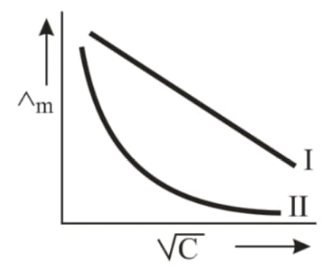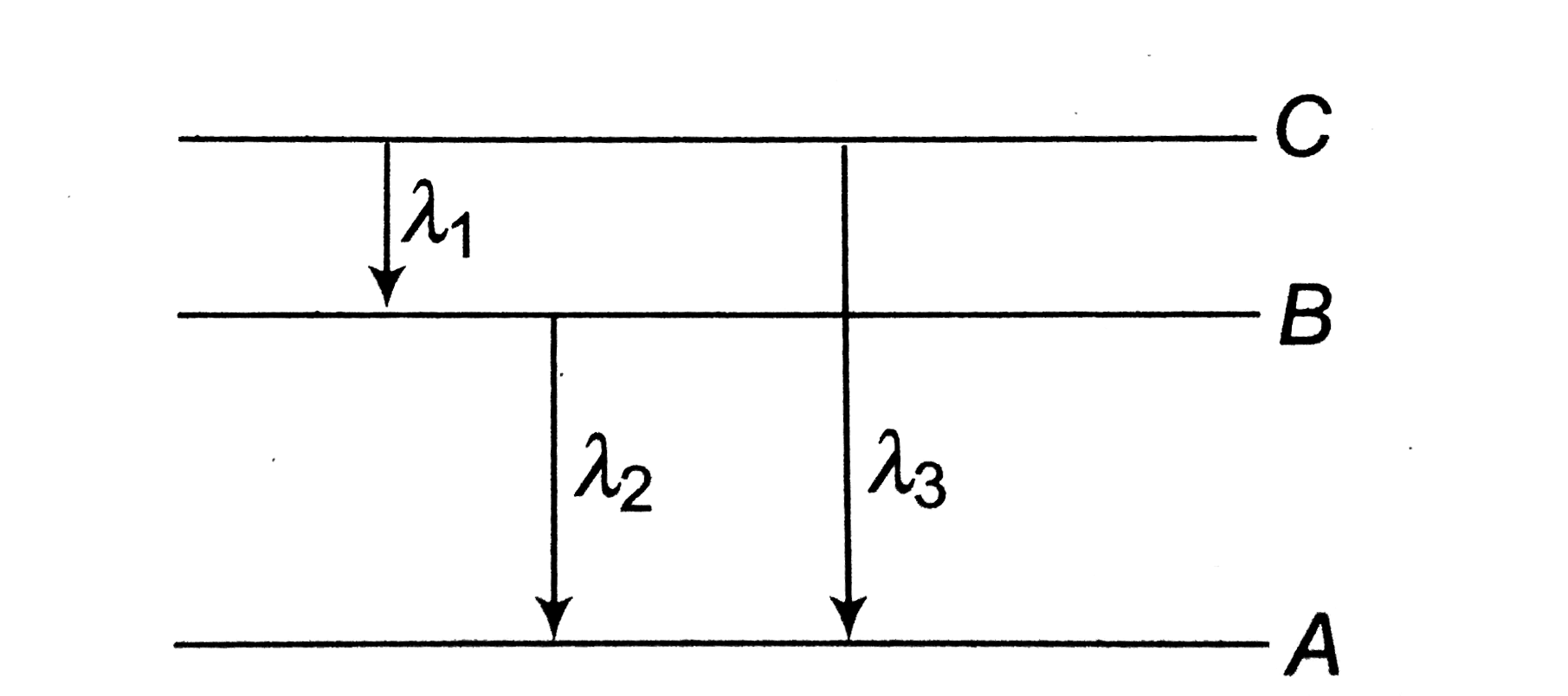The variation in Λm with concentration for a strong electrolyte can be represented by the equation, Λm=Λ∘m−AC1/2 The value of constant A for a given solvent and temperature depends upon the type of electrolyte i.e., cations and anions produced on dissociation of electrolyte in the solution .
Which of the following statements is correct regarding variations of molar conductivity with concentration.
Molar conductivity decrease with decrease in concentration
Variation in molar conductivity of weak and strong electrolytes is same.
Molar conductivity increases with decrease in concentration.
When concentration of the solution approaches zero, the molar conductivity is known as conductance.
The correct Answer is:C
To solve the question regarding the variation of molar conductivity (Λm) with concentration for a strong electrolyte, we will analyze the given equation and derive the implications step by step.
Step 1: Understanding the Equation
The equation given is:
Λm=Λ0m−AC1/2
Where:
- Λm is the molar conductivity at a certain concentration.
- Λ0m is the molar conductivity at infinite dilution.
- A is a constant that depends on the type of electrolyte and the solvent.
- C is the concentration of the electrolyte.
Step 2: Analyzing the Terms
From the equation, we can see that:
- As the concentration C increases, the term AC1/2 also increases because A is a positive constant and C1/2 increases with increasing C.
- Since Λ0m is a constant, the equation shows that Λm decreases as C increases.
Step 3: Conclusion on Molar Conductivity
From the analysis, we conclude:
- When the concentration of the electrolyte increases, the molar conductivity Λm decreases.
- Conversely, this means that molar conductivity increases when the concentration decreases.
Step 4: Selecting the Correct Statement
Given the analysis, the correct statement regarding the variation of molar conductivity with concentration is:
- Molar conductivity increases with a decrease in concentration.
Final Answer
Thus, the correct option is:
- Molar conductivity increases with decrease in concentration.
---
The equation given is:
Λm=Λ0m−AC1/2
Where:
- Λm is the molar conductivity at a certain concentration.
- Λ0m is the molar conductivity at infinite dilution.
- A is a constant that depends on the type of electrolyte and the solvent.
- C is the concentration of the electrolyte.
From the equation, we can see that:
- As the concentration C increases, the term AC1/2 also increases because A is a positive constant and C1/2 increases with increasing C.
- Since Λ0m is a constant, the equation shows that Λm decreases as C increases.
From the analysis, we conclude:
- When the concentration of the electrolyte increases, the molar conductivity Λm decreases.
- Conversely, this means that molar conductivity increases when the concentration decreases.
Given the analysis, the correct statement regarding the variation of molar conductivity with concentration is:
- Molar conductivity increases with a decrease in concentration.
Thus, the correct option is:
- Molar conductivity increases with decrease in concentration.
Topper's Solved these Questions
- ELECTROCHEMISTRYBOOK - NCERT FINGERTPS ENGLISHCHAPTER - ELECTROCHEMISTRYEXERCISE - HOTS
10 Videos
- ELECTROCHEMISTRYBOOK - NCERT FINGERTPS ENGLISHCHAPTER - ELECTROCHEMISTRYEXERCISE - EXEMPLAR PROBLEMS
17 Videos
- COORDINATION COMPOUNDS BOOK - NCERT FINGERTPS ENGLISHCHAPTER - COORDINATION COMPOUNDS EXERCISE - Assertion And Reason
15 Videos
- GENERAL PRINCIPLES AND PROCESSES OF ISOLATION OF ELEMENTSBOOK - NCERT FINGERTPS ENGLISHCHAPTER - GENERAL PRINCIPLES AND PROCESSES OF ISOLATION OF ELEMENTSEXERCISE - Assertion And Reason
15 Videos
Similar Questions
Knowledge Check
The variation in Λm with concentration for a strong electrolyte can be represented by the equation, Λm=Λ∘m−AC1/2 The value of constant A for a given solvent and temperature depends upon the type of electrolyte i.e., cations and anions produced on dissociation of electrolyte in the solution .
NaCl, MgCl2 and CaSO4 are known asA1-1,2-1, and 2-2 type electrolytes respectivelyBstrong, weak and strong electrolytes respectivelyCelectrolytes with different value of ADelectrolytes with same molar conductivity .
The molar concentration of HCl (aq.) is 10−5M. Which of the following statement are correct (dsolution = 1 gm/cc)
View Solution
Above plot represents the variation of molar conductance against √C (where C = molar concentration of the electrolyte) . Select the correct option among following .
View SolutionThe molar conductivity at infinite dilution of a strong electrolyte can be obtained by extrapolating the curve λm versus √c but same cannot be done for a weak electrolyte. Explain.
View SolutionConsider the statements S1 and S2:
S1: Conductivity always increases with decrease in the concentration of electrolyte.
S2: Molar conductivity always increases with decrease in the concentration of electrolyte.
The correct option among the following is:
View SolutionConsider the statements S1 and S2.
S1: Conductivity always increase with decrease in the concentration of electrolyte
S2: Molar conductivity always increases with decrease in the concentration of clectrolyte. The correct option among the following is:
View SolutionSolutions of two electrolytes A and B are diluted. The Λm of 'B' increases 1.5 times while that of A increases 25 times. Which of the two is a strong electrolyte? Justify your answer.
View SolutionEnergy levels A,B,C of a certain atom corresponding to increasing values of energy i.e., EA<EB<EC. If λ1,λ2,λ3 are the wavelengths of radiations correspnding to the transitions C to B,B to A and C to A respectively, which o fthe following statements is correct?

View Solution
